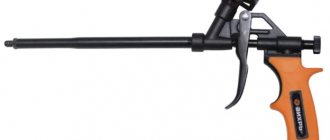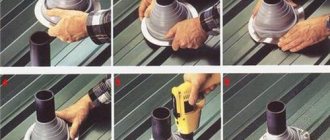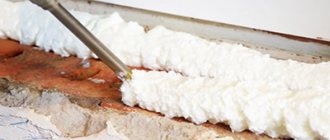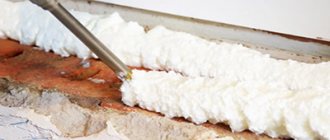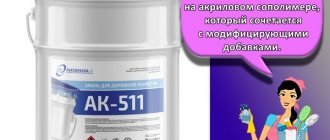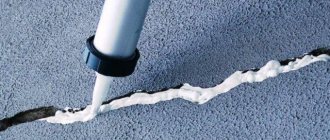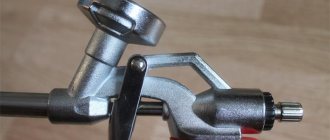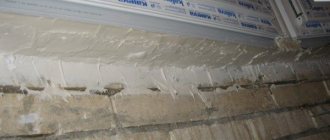When buying a material, consumers of polyurethane foam pay attention to the requirements that it must meet: the level of shrinkage after polymerization, adhesion index, ductility, fragility. But few people focus on the question: whether the material burns after drying or not.
This question concerns buyers who have some experience in carrying out repairs, or those who want to increase the level of fire safety of the premises, using fire-resistant plasterboard and other materials that resist fire.
Foam sample
Polyurethane foam: what it is and how it works
Foamed polymer is a universal material that hardens very quickly in the open air. We suggest studying the description of polyurethane foam, its composition and principle of action. The polymer is produced only in metal cylinders in which it is under high pressure. The foam inside the tank is in a liquid state.
What does polyurethane foam look like after being squeezed out of an aerosol can Source hlamer.ru
Is phenol a big threat?
Phenol is considered a toxic substance because it emits toxic fumes, and this process can continue for years without reducing or losing toxicity. This chemical element can cause disruption of the most important systems of the human body: respiratory, nervous, cardiovascular. The consequence may be headaches, loss of consciousness, and impaired coordination of movements. Kidney and liver function may also be affected. Constant contact with phenol and its vapors can cause the appearance of such serious diseases as asthma, infectious pulmonary pathologies, and allergies.
According to scientists involved in research in this area, the use of polyurethane foam for the manufacture of children's furniture, mattresses, and toys is unjustified. Polyurethane foam may well be replaced with safer materials. If parents are concerned about the health of their children, they need to be very careful when choosing toys and mattresses for them, in which polyurethane foam can be used as a filler. The majority of civilized countries have banned the production of everyday goods.
Types of polyurethane foam
For each manufacturer, the types of foam may differ not only in performance characteristics, but also in internal composition and even in area of application. We suggest exploring the possible options so that, in the future, when choosing them, you do not make mistakes:
- Household. One of the most common types. The bottle with this foam comes with a tube that allows you to fill any hard-to-reach places. This part helps eliminate the need to use a special mounting gun. The secondary expansion rate of this type of material is usually very large, but the output volume is maximum. A common practice is that the gas runs out much earlier than the polymer itself, so all that remains is to throw away the half-used cylinder. This is disadvantageous.
- Professional. A higher quality type of polyurethane foam, used for large-scale work. For example, if necessary, install metal-plastic windows, double-glazed balcony windows, and install window sills. The product cylinders are equipped with a special ring valve. It is necessary for screwing the mounting gun to the container. After installing the reservoir with the polymer in the nozzle, the foam passes into the latter until it stops at the cutter. The valve itself is subsequently controlled by a trigger when it is necessary to fill voids.
- One-component. This type of material consists only of polymer and extrusion binders. It is the simplest and is used for everyday needs and general use. Considered affordable.
- Two-component. Another variety with a small area of application. Also, this composition cannot be found on the open market, but is provided exclusively on order. To work with such a composition, you need to mix two components, and this requires special skills. After preparing the composition, it must be used quickly to avoid hardening.
- Summer. This type of polyurethane foam is used only at positive temperatures. That is, the material creates an effective seal when used in the temperature range from +5 and above.
- Winter. The composition of the polymer differs significantly from its predecessor. Therefore, it can be used in frosts down to -20 degrees. The same composition is effective for use in industrial refrigerators and freezers if necessary. But under such conditions, it must be taken into account that the temperature of the foam container must be positive.
Varieties of polyurethane foam with different volumes of composition output Source ferenc.ru
Vikoristannaya mounting pin
The peculiarities of the vicoristic bud to lie in plain sight. The scraps after cutting into the warehouse become more difficult to handle, it is necessary to ensure the dimensions of the filling slots: narrow empty ones are easier to fill with a warehouse with small expansions.
When filling a large space, apply ball by ball, turning the front ball after polymerization. There is also a basic technology in which the opening is first filled with filler (for example, crushed stone) and then the foam material is stagnated with slight expansion.
Flammability classes
The flammability class is one of the main technical parameters that is assigned to each building material. Therefore, polyurethane foam is no exception. Let's look at the notation and explanation:
- B1 - is fireproof;
- B2-considered flammable but self-extinguishing;
- B3—flammable.
The best option for all cases is a composition with a fire-resistant class. This can even be used when installing heating equipment, when contact with hot surfaces is inevitable.
Flammability class of one-component polyurethane foam Source onlinetrade.ru
Biogenic properties
Polyols and polyisocyanates used for the production of polyurethane foam are petroleum products. However, it is known that polyurethane foam components can also be produced from vegetable oils. The best option for this purpose is castor oil. The polyol component can also be obtained from sunflower, soybean, and rapeseed oils. However, the cost of these raw materials is quite high and production is not economically feasible. Biogenic polyurethane foam materials are produced in small volumes and are used to solve very narrow specific problems.
Cylinder volumes
This section focuses on canister capacity and, in particular, how much work can be done with one unit of resin.
- 300 ml - this volume is characterized by a yield of approximately 20 liters. This amount will be enough to install the box when installing a standard double-glazed window with dimensions of 1.2x1.5 mm.
- 500 ml - yield can reach approximately 35 liters. Ideally, this volume is enough to fill a door frame in an opening measuring 0.8x2 meters. But this is only subject to rational use of the material.
- 750 ml - in this case, the output can fluctuate in the range of 40-70 liters. This amount of polyurethane foam should be enough to install three double-glazed windows with standard sizes.
Practice shows that the ideal solution when choosing a sealant is to choose a larger volume of material than initially needed, since it is always necessary to have some reserve.
Professional polyurethane foam for construction Source Yandex.Zen
Sleeping in the arms of PPU...
We will talk about such bedding items as polyurethane foam mattresses. Harm, quite serious, can be caused by inhaling fumes of complex volatile chemical compounds (about 30 types), the most dangerous of which are phenol and 2-ethylhexanoic acid. Moreover, new mattresses filled with polyurethane foam emit 5-6 times more hazardous substances into the atmosphere than old ones. The concentration of vapors of these substances is comparable to emissions from a new laminate flooring.
Assurances about the safety of mattresses filled with polyurethane foam are questionable for the simple reason that at the stage of their manufacture resins, catalysts, solvents, and active chemical components (phenol!) are used.
Polyurethane foam - GOST
In addition to all other features and parameters, it is important to know the GOSTs that each type of polyurethane foam must comply with. We suggest studying everything in detail in the table.
| Property | Meaning |
| Density | 25-30 kg/m3 |
| Tensile resistance | 0.12 N/mm2 |
| Bending capabilities | 17 kg/cm2 |
| Tensile strength | 12 kg/cm2 |
| Drying the top layer | 20 minutes |
| Cutting time at 50% humidity | Not earlier than 4 hours later |
| Hardening period | 24 hours |
| Stability in volume | 7% |
| Compression/Adhesive Strength | 3 N/cm3 |
| Heat resistance | -40-+90 degrees |
| Ignition temperature | At least 400 degrees. |
What is a mounting pin?
This is a sealant based on polyurethane foam. The main components of polyurethane foam: methylene diphenyl diisocyanate, polyols, catalysts, stabilizers and foaming agents.
The warehouse is kept in an aerosol can in a rare state, and when it comes into contact with moisture, which is present in the wind, it polymerizes and hardens. Therefore, the foam material perfectly fixes the structures, and also stabilizes them during minor movements. Since the warehouse is clear, it copes quite well with the fixation of massive elements.
The “spaghetti” effect - what is it and is it possible to cope with it?
Installers often use the term “spaghetti effect” when performing any work involving the use of foamed polymer. It implies incorrect release of polyurethane foam from the container, that is, when the material flows in in a thin stream and practically does not expand upon contact with air.
This happens when you buy a low-quality tank, especially with the tip, when it does not open completely, causing a defect.
Consequences of a faulty nozzle on a cylinder with polyurethane foam Source graficart.ru
Properties of polyurethane foam
Polyurethane foam produced by domestic and foreign manufacturers has a number of both positive and negative characteristics.
Low (0.019 - 0.03 W/m), almost complete vapor permeability, water resistance make polyurethane foam an excellent heat and water insulator. The same can be said about sound insulation. The high adhesion coefficient makes it possible to apply polyurethane foam to almost any surface.
However, polyurethane foam is not characterized only by its positive qualities. Harm to human health can be caused during the burning of polyurethane foam (in the presence of a direct source of fire, the material burns). In addition, polyurethane foam releases toxic substances into the atmosphere - formaldehyde. Polyurethane foam, the components of which interact with air and are exposed to sunlight. Over time it darkens and falls off.
Pros and cons of polyurethane foam
Any building material has certain pros and cons. Let's take a look at what concerns polyurethane foam.
Advantages:
- used not only as a sealant, but also as a heat and sound insulator;
- considered a binding material;
- does not conduct electric current;
- is not vulnerable to moisture;
- depending on the flammability class, it may be non-flammable;
- perfectly fills all voids due to good expansion
Minuses:
- under the influence of ultraviolet rays it tends to collapse;
- Full, unused cylinders should be stored at room temperature, away from heat emitters
- It can eat into the skin, and it is problematic to wipe it off, especially if it has already hardened.
In general, if you take precautions when using polyurethane foam, the material will be considered absolutely safe.
High-quality gun for spraying polyurethane foam Source onlinetrade.ru
Requirements
Actually, the only requirement according to regulatory documents for this type of fire-fighting products is the fire resistance indicator, determined according to GOST 30247.0-94, which is still in force today, on methods for testing building structures, materials used in the construction and finishing of buildings for fire resistance.
In particular, fire-resistant foam has a fire resistance limit characteristic of EI, which means testing its limit states under intense fire influence on integrity and loss of thermal insulation ability.
As has already been seen from the parameters of similar products available on the Russian market, this indicator varies for different types and types of goods - from 60 to 360 minutes.
How to properly use foamed polymer from a balloon
Before you start filling cracks with foam or making airtight connections, you need to thoroughly study the rules for using this material.
- Before installing the cylinder into the gun, put on gloves and a respirator (in particular, this applies to people who develop allergic reactions to spraying aerosol products).
- Before using the can directly, shake it for 30-60 seconds. The foam should mix well while still inside the container. If this procedure is omitted, then when you press the trigger of the gun, resin will come out of the nozzle.
- Wet the gap or any other area that will be filled with foam with water. Just do it lightly, not generously, for better fixation of the aerosol material.
- The next step is to turn the can over so that its bottom is facing up and slowly press the gun lever. Apply pressure evenly—the polymer should be well distributed over the desired area.
- If the gap is vertical, then fill it with material only from bottom to top and only to 1/3 of the depth. Since the material tends to expand, during the solidification process it will completely fill the entire gap.
Basically, the foam will be ready for cutting within thirty minutes after application, provided that the rules of use are followed. Also, immediately after removing the excess, the sealed areas can be plastered. Even if the composition is not completely dry inside, it will harden over time.
Recommendations for use
The fireproof version of the material is an environmentally friendly product. The foam mass is non-toxic and does not cause allergic reactions. But application carries a certain danger to human health - the lungs and bronchi are exposed to the harmful effects of substances. It is recommended to follow safety rules during application and during the drying period.
Protective measures:
- Respirator;
- Workwear;
- Gloves.
It is not allowed to heat the cylinder to a temperature exceeding +50 degrees Celsius. If the substance gets into the eyes or mouth, wash them immediately with plenty of running water and seek medical help without fail. The room must be well ventilated during operation.
When selecting material for work, pay attention to the indicators that are placed on the cylinder. The type of foam, level of flammability, certification, and fire resistance class deserve special attention.
This video clearly shows whether a material burns or not (testing regular and heat-resistant material):
